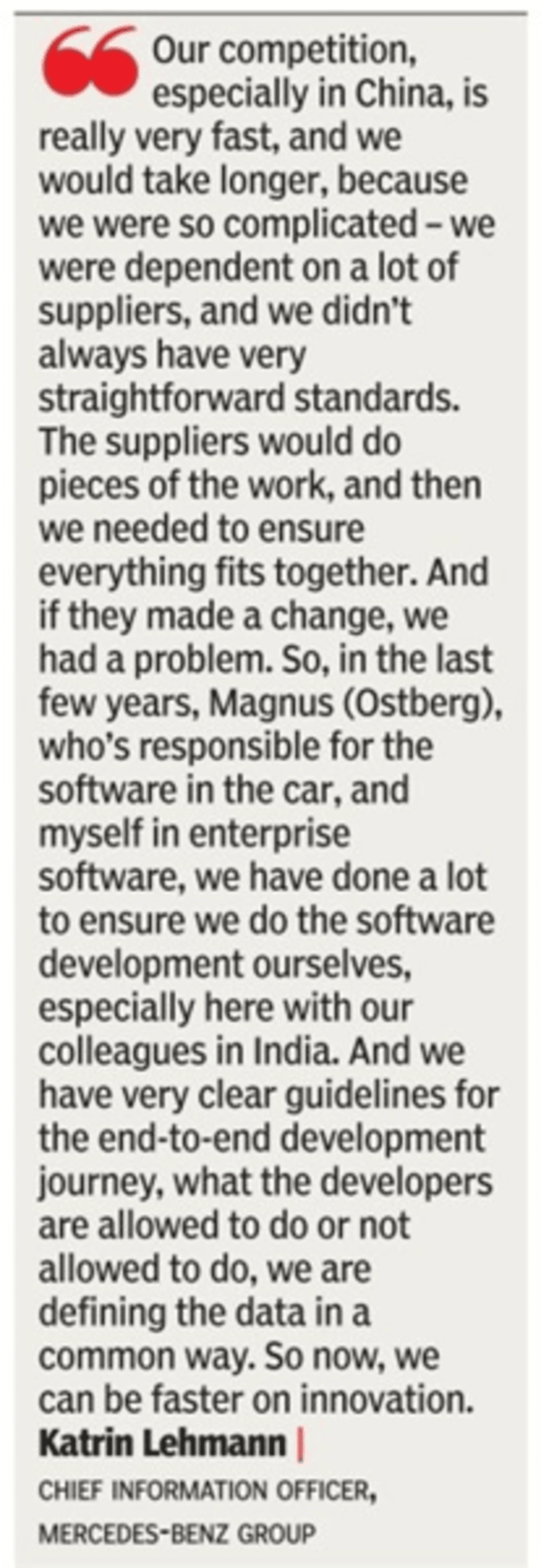On a visit to the Mercedes-Benz R&D India (MBRDI) centre in Bengaluru in November, Katrin Lehmann was so impressed with the presentations her teams here made, that a couple of months later, Mercedes-Benz’s chief information officer decided to make yet another visit, this time with her entire team from Germany, some 16-17 people. “I really said, I need my whole team to come here and see this,” she tells us.
MBRDI is Mercedes-Benz’s largest R&D centre outside Germany, with over 8,500 people. A significant part of Katrin’s team sits here. Bengaluru is also important because two of her biggest partners have major bases here – SAP and Infosys. In the two days prior to our meeting, she had been to both those campuses. That reinforces a point some in the GCC ecosystem make, that Bengaluru has an advantage almost no city on the planet has – partner companies within a few kilometers of one another. And it’s a great mix of GCCs, tech companies, and IT services companies. That proximity is seen to really accelerate innovations.
With Infosys, Mercedes-Benz had signed a multi-year $3.2-billion deal in 2020 to drive hybrid cloud-powered innovation and IT infrastructure transformation. The SAP campus in the city is one Katrin has long been familiar with, having spent over 21 years in the German enterprise software company, before moving to Mercedes-Benz in 2023. That stint had brought her to Bengaluru many times.
SAP was, of course, only about software, and Katrin now likes the idea of combining software with something that one can touch and feel – and drive.
IT, she notes, has a completely different position in Mercedes-Benz today. “It’s still a product company and everyone’s excited about the cars. But IT and software and technology is now the thing. Otherwise you cannot run an automotive company anymore,” she says.
Digital twins for plants, carsEverything today starts digitally, be it building a new plant or car, or changing something in an existing plant or car. Digital twins are dramatically reducing costs, reducing planning times, and accelerating innovations. “If the market demand is changing, and we have to understand, does this car even fit onto this manufacturing line, we can simulate it now with a digital twin. We can check if it will work. We can digitally simulate to see if a worker will have the space to produce a car on a particular production line. Crash tests are simulated digitally first before we do physical crash tests,” Katrin says.
When a vendor needs to supply a new component for a new plant or car, Mercedes-Benz shares the digital twin information of the plant or car, and the vendor can check how they can put their piece into the car, before producing even a single physical prototype.
Digital twins, Katrin says, have become very accurate. “You need a lot of historical data and planning data to build the digital twin, and then you need huge compute to be able to process the vast amounts of information and put into the metaverse,” she says.
AI’s predictions really goodGenAI, Katrin says, is being used in all departments, and everywhere it’s seen to be working well. It’s helping predict – way better than previously – how much paint will be required to paint a car, based on factors like environmental conditions. This has significantly reduced the amount of paint and energy the company consumes.
On the production floor, if there is a problem in the manufacturing process, workers can simply ask the system how to deal with the problem. And if the same problem had been dealt with in some other part of the world, the system instantly fetches the answer.
AI agents have been built to help developers understand SAP’s ABAP code written decades ago that did not have documentation. AI is helping to migrate more easily from mainframes to cloud infrastructure and systems.
And it’s helping with sales and operations planning – predicting what kind of cars and which models are likely to be in demand. “We have people that have been around for 20 years, whose predictions are usually pretty close to what the system does. But if you have new people joining, how would they know? It takes a long time to get this understanding of the market and which factors you need to use. So this now helps us ramp up people quicker,” Katrin says.





















